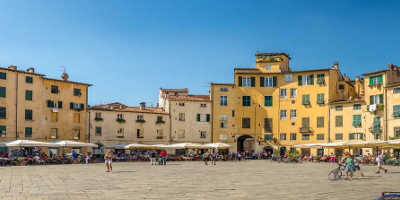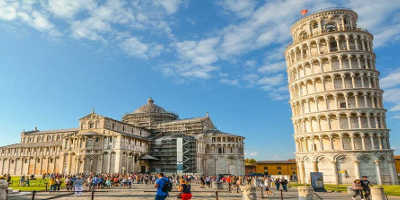Is it worth climbing the Pisa Tower?
Climb to the top of the leaning tower of Pisa and enjoy a unique experience!
Whacked on many of Italy’s postcards, the Leaning Tower of Pisa is one of the most recognisable landmarks in the region. As one of the country’s signature sights, the tower brings a herd of travellers to this small city of Pisa. But is it worth taking the time out of your holiday to visit this one landmark, and climbing to the very top to see the view?
The making of the Leaning Tower of Pisa
The construction of the Tower began in 1173, with the building originally designed to be a bell tower by engineer Bonnano Pisano. The original building was a marble foundation large enough to park about 16 Ferrari within it, a medieval architecture, in Romanesque style. However, the tower faced numerous issues throughout its construction, with wars, debts, and most particularly the lean. By the tower’s third floor construction, the building was already leaning. After this, works stopped for 100 years, as the government focused all extra money on their war with Genoa. Work started again in 1272 and four more floors were added in an altered angle to the previous levels to try and get the tower even. However, this led to the Tower of Pisa to start leaning in the direction of the taller side instead. In 1284, construction was ceased again as Pisa was conquered by Genoa in another war. In 1370, the tower was officially completed, standing at eight stories high.
Why it leans
The tower truly lives up to its name, leaning a startling 3.9 degrees off the vertical. The reason for its lean is due to the foundation, which was built in a five feet deep circular ditch, settling on the ground that had a layer of clay, fine sand, and shells. The clay mixture slowly crushed the soil, washed together by subterranean waters. The clay was also not strong enough to hold the tower upright, making the weakest point of the tower slowly sink, leaving a slight lean to the building.
The Solution to the Lean
Many different solutions were thought of to compensate for the lean. Giovanni di Simone was the first person to construct a solution. Adding more floors to the building, which were all built a degree taller than the leaning side. This only caused the tower to lean over even more.
In 1319, a seventh-floor was completed that added seven bells, all making up of a weight of 10 metrics tons. The bells were also operated by ropes, which swung the bell weight around, leading to the tower to sink even further.
In 1838 architect Alessandro Della Gherardesca thought of another solution. Digging a pathway at the base of the tower, allowing people to admire the intricately crafted base. However, this caused the tower to lean even more.
In the 1920s the foundation of the tower was injected with cement grouting, to help stabilize the tower to some extent.
Finally, in the tower was completely closed to the public from 1989 until 2001, as the tower’s eventual fall was fast approaching. By tapping earth from beneath and adding counterweights to the tower’s north end, the construction team were able to reduce the lean-to only 4.0 degrees. The straightening continued after the tower reopened in 2001, and in 2008, it stated that the tower will remain stable for the next 300 years.
Why it’s worth the trek
There are 251 steps to the top of the Leaning Tower of Pisa, with the winding spiral staircase an easy climb upwards. It takes around 30 minutes to climb the entire tower, with most traveller finding it easy, with only a few reported to feeling dizzy from the tight, inclined staircase.
It is a breathtaking sight of the city
Most tourist snaps of this tower may be on the grass nearby, with tourists using optical illusion so it seems they are holding up the tower with just their sheer strength. However, another underrated snap is from the view top of the tower. Boasting stunning views of the entire city, as well as the lush greenery of the beyond fields.
It is an architectural wonder
Despite its slight lean from the numerous blunders of the designers, the building is still an architectural wonder. Built-in the beginning in the 12th century with inadequate foundation, it still has survived for quite a long time despite its rickety groundwork. As well, its beauty is terrific, built in the medieval Romanesque style, the numerous columns, the marble material, and the stunning bells and paint decorations make it an incredible building to see in person.
You can see Piazza dei Miracoli from a different angle
This World Heritage Site might not attract as much attention as its neighbouring tower, but it truly leaves visitors dumbstruck. The cathedral steals the show in Pisa, with the tower being just one component of a 3-part complex of buildings. It was built to show a symbol of the power of the city of Pisa, built with extraordinary care to create this architectural masterpiece. Climbing up the Pisa tower gives you an impressive view of the cathedral from above, letting you admire the detail and beauty of this iconic landmark.
How to Climb the Tower
- November and February: The tower’s doors open between 9:45 am until 5:15 pm.
- On November 1st: open between 9:00am until 6:00pm
- December and January: The Tower is open 10:00 am until 5:00 pm
- On December 5th to the 8th: open between 9:00 am until 6:30 pm
- From December 21st to January 6th: open between 10:00 am – 7:00 pm
- March: The Tower opens from 9:00am until 6:00pm
- From March 23rd-29th, open between 9:00am until 7:00pm
- From March 30th, the tower is open 8:30 am-8:00 pm
- April to September: The Leaning Tower is open from 9:00 am until 8:00 pm
- Between June 17th and August 31st: open 8:30 am-10:00 pm
- On June 16th: open 8:30am-5:30pm
- October: open between 9:00am until 7:00pm
Related article: How to get a photo ‘holding up’ the Leaning Tower of Pisa?



